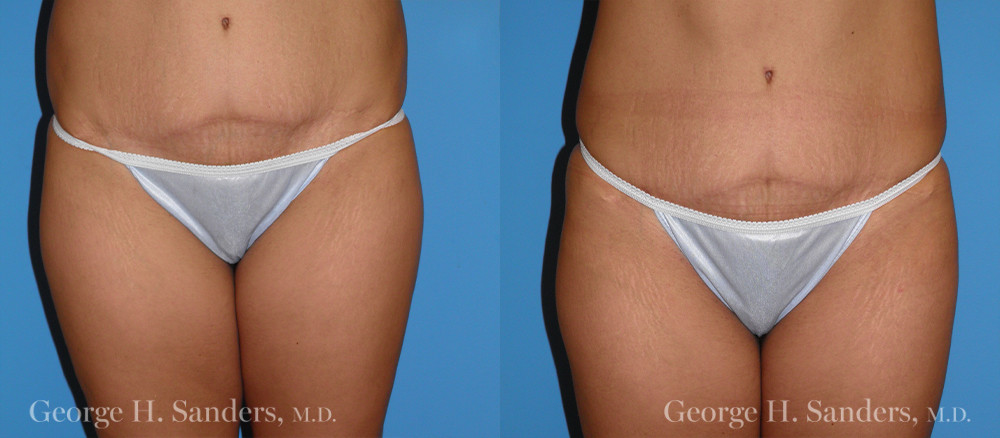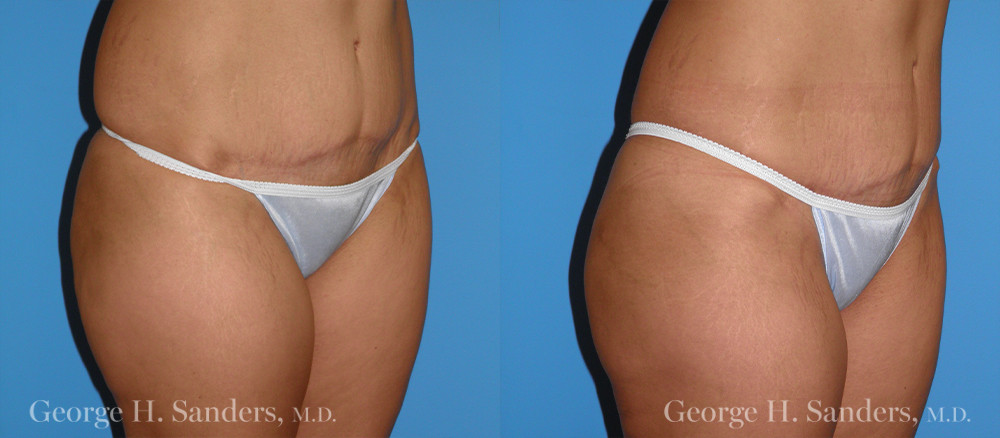Liposuction Overview
Liposuction is used to remove fat from just under the skin and thus reduce bulges that are due to excess fat. By undergoing liposuction, patients can enhance their appearance and greatly improve their self-confidence. Dr. Sanders utilizes the advanced techniques of Tumescent, Ultrasonic assisted Liposuction, as well as Microliposuction to contour a shapely body as he removes fat cells in the hips, thighs, buttocks and other areas. These procedures can be performed separately, or in conjunction with sculpting other areas of the body, including:
- Hips
- Thighs
- Upper arms
- Abdomen
- Buttocks
Liposuction is not a weight-loss procedure, however.. Instead, it focuses on giving you a more contoured look.
Who is a good candidate for Liposuction?
The best candidates for liposuction are those who are in good health, but who have been unable to completely eliminate unsightly bulges with diet and exercise.
You may be considered a good candidate for liposuction if you:
- Are in overall good health
- Are within 30 percent of your ideal weight
- Have firm, elastic skin and good muscle tone
- Have fat deposits on your body that don’t respond to diet and exercise
Types of Liposuction Procedures
include non-surgical techniques, which treat the fat with extreme cold, ultrasound, and lasers, as well as the surgical technique of liposuction. Although the non-surgical techniques allow you to avoid surgery, the results take weeks to months to appear and frequently require touch-ups. On the other hand, liposuction is a one-time procedure in most cases, and the results are immediately seen, although they improve for several months. Liposuction also allows for treatment of multiple body areas as opposed to much more limited treatment areas with the non-surgical techniques.
There are different types of liposuction techniques available, which include tumescent, ultrasonic-assisted, laser-assisted, power-assisted and micro-liposuction. In his practice, Dr. Sanders primarily utilizes micro-liposuction.
Micro-liposuction involves the use of tiny suction cannulas for fat removal, creating minimal scars and minimizing any skin irregularities after surgery. The procedure may be performed under local anesthesia or sedation anesthesia. It begins with the injection of fluid that contains local anesthetic and epinephrine to minimize bleeding and maximize the amount of fat removed.
Skin Tightening After Liposuction with Renuvion
Dr. Sanders has incorporated an innovative technique called Renuvion into his practice to enhance skin tightening, which can be done at the same time as the liposuction procedure. It may also be done as a stand-alone procedure. This cutting-edge technology utilizes plasma energy to stimulate collagen production and tighten the skin without causing damage to the surrounding tissues.
By combining Renuvion with liposuction, Dr. Sanders ensures that his patients not only achieve a slimmer silhouette, but also tighten lax skin.. This dual approach results in a more natural and youthful appearance, while minimizing the risk of sagging or loose skin post-procedure. Patients who undergo this treatment report high satisfaction levels due to the impressive and long-lasting results.


What Patients Are Saying About Us
Recovering from Liposuction
Everybody recovers differently from liposuction, but in general, Los Angeles patients can expect a bit of downtime after their procedure. Right after the surgery, patients will experience some bruising and swelling, as well as slight soreness. To promote healing, they’ll need to wear support garments that apply gentle pressure on the treatment area to minimize bruising and swelling, and also to keep everything precisely contoured. These garments are usually worn for up to six weeks, but Dr. Sanders will make a personalized recommendation for each patient.
Most Los Angeles patients can get back on their feet a day or so after surgery, and then they’re encouraged to take short walks to facilitate recovery. Usually, they can go back to work shortly thereafter, with full resolution of all swelling taking up to six months.
Liposuction FAQ
-
How Much Does Liposuction Cost?
The price of liposuction varies due to the type of liposuction selected, the number of areas being treated and other individual factors. Dr. Sanders will be able to provide you with a more accurate price estimate during your one-on-one consultation. At that time, you may also wish to ask Dr. Sanders about the financing options that he offers, which create an affordable monthly payment method with low to zero interest.
-
Does my insurance cover the procedure?
Most insurance providers will not cover liposuction treatments because they are considered cosmetic. However, Dr. Sanders does offer financing options to help you pay for treatment with affordable monthly payments.
-
Are there any risks involved?
The risks for a micro-liposuction procedure are fewer than with a traditional liposuction. Rarely, people can experience dimpling, loose skin, and scarring. Dr. Sanders will discuss any risks during your consultation so you know what to expect.
-
What areas of the body can be treated with liposuction?
Liposuction can treat many areas of the body, including the: Abdomen, Flanks, Hips, Thighs, Buttocks, Male chest, Knees, Upper arms, Cheeks, and Neck.
-
Is liposuction permanent?
After healing from liposuction, the treated area maintains the same shape even with changes in weight. Once removed via liposuction, fat cells do not grow back. However, gaining a significant amount of weight after liposuction could affect the results of surgery. Dr. Sanders recommends eating right, exercising regularly and practicing portion control after recovering from surgery.
-
Does liposuction leave scarring?
The liposuction incisions are small and usually heal very well. Dr. Sanders always tries to hide the incisions by paying close attention to the location and direction of the incision.
-
What is tumescent liposuction?
Tumescent liposuction involves injecting a special tumescent solution (fluid containing epinephrine and lidocaine) into the fat, causing it to swell and firm before it is removed. Tumescent liposuction allows for less intraoperative bleeding and postoperative bruising.
-
Can I have liposuction if I am overweight?
Liposuction is not a suitable method of weight loss, nor is it recommended for individuals who are more than 50 pounds above their ideal weight. Dr. Sanders recommends losing to within 10 pounds of your goal weight before considering liposuction.
-
Do I need to wear a compression garment after surgery?
Compression garments are helpful for reducing bruising and swelling after surgery and helping the tissues heal properly. The garment is placed over the treated area and should be worn for several weeks, per Dr. Sanders’ recommendation.
-
What Are Some Ways to Get Rid of Belly Fat?
Losing weight will reduce the amount of fat inside the abdomen, an area that liposuction cannot address. To accomplish this, appropriate diet and exercise are of great benefit. For some patients, the new glucagon-like peptide – 1 agonists (GLP-1’s) like Ozempic may also be of great benefit. Seek medical advice if you wish to consider this option.
It can be difficult to know just how liposuction will affect skin elasticity until a patient has seen Dr. Sanders at his San Fernando Valley office. Patients’ skin types vary widely, so Dr. Sanders will need to perform a physical examination to determine the degree to which a patient’s skin may be affected. Some factors that can contribute to poor skin laxity after liposuction include:
- Pre-existing poor skin tone and laxity from things like pregnancy, a history of weight gains and losses, significant sun exposure, or cigarette smoking.
- Age over 40, as the skin naturally loses its elasticity with age
Because of these factors, Dr. Sanders will carefully consider whether liposuction is right for his patients before recommending the procedure.
-
Can I Lose Weight With Liposuction?
Contrary to popular belief, liposuction is not a quick and easy way for patients trying to lose weight. Rather, it’s a procedure that’s intended to benefit those who are unable to eliminate stubborn pockets of fats. It’s a great shaping procedure, not a weight loss technique. In fact, if a patient is too overweight, Dr. Sanders may even recommend against liposuction because it may not provide the desired benefit for the patient. The ideal candidate is someone who has already lost the majority of their weight but needs help with shaping the body.
Technically, patients may drop up to ten pounds after the surgery, but if seeing numbers go down on the scale is the primary goal, Dr. Sanders will also recommend that healthy lifestyle habits like diet and exercise be included in the treatment plan.
-
Is getting liposuction really worth it?
Liposuction may offer the chance to get that sleeker and more contoured look you want and may not have been able to get because of stubborn fat pockets.
Micro-liposuction offers the chance to get lasting results without going through a major surgical procedure.
Excellence in Liposuction in Los Angeles
Dr. Sanders is ready to help you achieve the results you want. He offers surgical and non-surgical options and uses techniques to minimize the risk of scarring and speed up recovery. For more information on liposuction or to learn if you may benefit from micro-liposuction, please contact Dr. Sanders’ Los Angeles office to schedule a consultation.